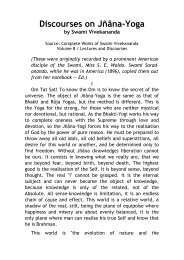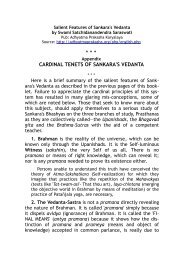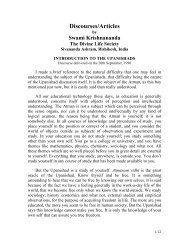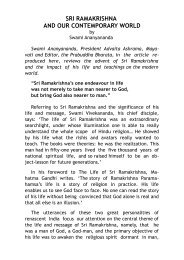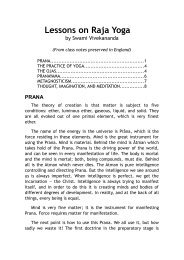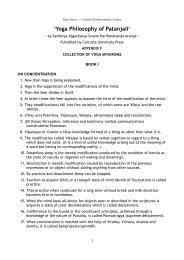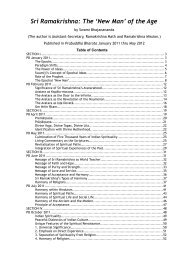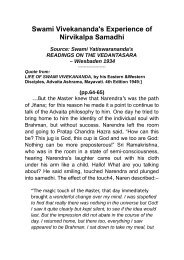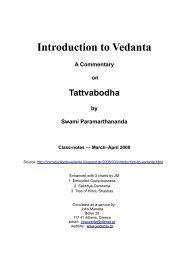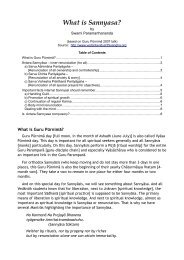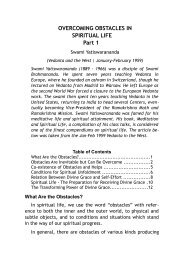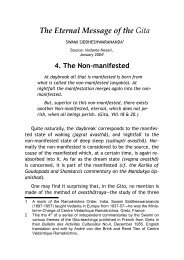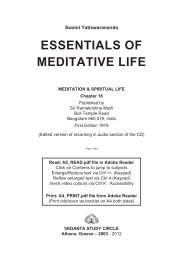Gita Summaries: Chapters 1-11 - Vedanta
Gita Summaries: Chapters 1-11 - Vedanta
Gita Summaries: Chapters 1-11 - Vedanta
Create successful ePaper yourself
Turn your PDF publications into a flip-book with our unique Google optimized e-Paper software.
Swami Paramarthananda on <strong>Gita</strong> – <strong>Summaries</strong> of Chaps 1-<strong>11</strong><br />
Happiness, peace, security can only be experienced by knowing Para Prakriti; so hold on<br />
to Para Prakriti. Enjoy sunrise, relations with people but remember that purnatvam<br />
[fullness] can never be had here. So play with Apara Prakriti, nothing wrong but go<br />
beyond.<br />
What is Bhakti<br />
It is a series of Sadhana which will take one closer to God (or Para Prakriti).<br />
There are 3 stages of bhakti:<br />
Karma Laskhana Bhakti (Karma Yoga, active life contributing to society or Ishwara<br />
Arpanam. This will purify and refine the mind).<br />
Upasana Lakshana Bhakti ( Bhakti in form of meditation. Karma Yoga makes the mind<br />
extrovert and “meditation” will expand the mind – from Ekkaha Rupa Ishwara dhyanam<br />
[on individual form] to Vishwa Rupa Ishwara dhyanam [on universal form] to Arupa<br />
Ishwara dhyanam [on formless]). Learn to see the Lord in all forms.<br />
Jnana Lakshana Bhakti is the enquiry into Para Prakriti; study of scriptures.<br />
Are all the three compulsory Or is there a choice of sadhana<br />
There is no choice at all; our fundamental problem is ignorance. Ignorance will go away<br />
only with knowledge; but then the mind must be prepared. Karma Yoga and Upasana are<br />
preparatory disciplines aimed to make the mind “ogyahah” or qualified. A baby cannot<br />
straightaway go to college without going to primary school and secondary school.<br />
III) The third topic deals with two types of Bhakti; if Bhakti has to fructify into moksha<br />
there is one condition. It must be Nishkama Bhakti and not Sakama Bhakti. The latter is<br />
a worship for Apara Prakriti; material acquisitions. Nishkama Bhakti is the devotion and<br />
the motive is the attainment of the Lord and nothing else; mumukshutvam.<br />
Samsara is a travel between pain and pleasure; after pain, pleasure is most wonderful.<br />
From pleasure, pain is big knock. One might enjoy the pleasures of Swarga [heaven] but<br />
they have to come back to mosquito Madras one day. So, which is better Swarga or<br />
Ishwara Praapti [attainment of Ishwara] People come to spirituality after undergoing<br />
many knocks in life; they realize that peace and happiness cannot be found in this jagat<br />
[world]. Anything which is so fleeting, is dangerous to rely on. So Krishna advises that<br />
one must not be enamoured by this impermanent world.<br />
One must develop nitya-anitya vivekah —learning to discriminate between what is real<br />
and what is apparent— and develop vairagyam [renunciation] to transcend Ragah [likes]<br />
and Dvesha [dislikes]<br />
iv) Glories of Nishkama Bhakti [desireless devotion]<br />
If I go through spiritual disciplines then who will look after me Here we are only asking<br />
for a change in focus.<br />
First we go through God, for getting things from the Lord. Now shift the focus to; go<br />
through the experiences of the world to attain the Lord.<br />
28



